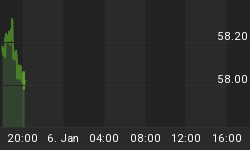Two Significant Shifts Put The Stock Rally In Doubt:
- Central bank action seems less likely in the short-run.
- A key risk-on ratio looks similar to past stock market peaks.
Unless Ben Bernanke can spark some renewed interest in risk assets, selling pressure could continue. Below we outline our concerns and what we will be watching in the days ahead.
Central Banks Could Disappoint
Prior to looking at a troubling chart for stock investors, it is important to understand what spooked the markets in recent days. The head of the European Central Bank, Mario Draghi, is not among the central bankers gathered in Jackson Hole this week. Mr. Draghi's absence has raised questions about the ECB's plans to intervene in the European bond market. On top of that, Dennis Lockhart, the Atlanta Fed president, threw some cold water on the QE3-is-coming-soon theory. Thursday morning, Lockhart told CNBC:
"If we were to see deterioration from this point, let's say a persistence of job growth numbers that were well below 100,000 per month, or see signs of disinflation that could signal the onset of deflation, then there wouldn't be much of a question about policy."
On August 28, we pointed out some caution flags on the chart of the S&P 500 (SPY) relative to intermediate-term Treasuries (IEF). While the chart that follows looks complex, it is based on the simple concepts of support and resistance. When the ratio is rising, stocks are in favor relative to bonds (see chart below). When the ratio is falling, bonds are strong relative to stocks. An updated version of the chart as of Thursday's close is presented here; the stock/bond ratio is at the top with the S&P 500 below it.
- Points A1 and A2 (see chart) show the twin peaks made by the S&P 500 last spring. Points B1 and B2, which occurred simultaneously with the stock market's peaks, show where the stock/bond ratio (SPY/IEF) was rejected by the downward sloping blue trendlines (acting as resistance for risk).
- Points C and E show where the stock/bond ratio is running into similar resistance in the present day. The red arrow to the left of B2 shows an important support break for "risk" relative to "risk-off" (see gap to left of arrow). The break of support for risk in April occurred on the same day the S&P 500 peaked at point A1.
- Point E shows a similar break of risk-on support that occurred on August 30 (this week). The two red arrows show similar support breaks for risk relative to risk-off. The horizontal line F could act as support for risk in the days ahead, meaning we must keep an open mind about where stocks go from here.
- The blue arrow shows the S&P 500 flirting with a break of support near 1,400 (bottom of chart). If stocks remain weak, point D shows an area near 1,388 where buyers may become interested again.

Back on the QE3 front, CNBC was told after the close Thursday by Charles Plosser, President of the Philadelphia Federal Reserve:
"My current assessment of the both the economy and effectiveness of QE is that I don't think it really meets the cost-benefit analysis."
Shorter and Shorter Rallies?
If you follow our work, you know we have been buyers of risk since early July. We have also made the case for higher highs in stocks, but not without some caveats. After the close on Thursday, we revisited some "shorter-duration" concerns that have prompted us to book some profits over the past two weeks. We have taken profits in oil stocks (OIH), oil (USO), Germany (EWG), and small caps (IWO). How could the market peak so soon after seeing bullish set-ups in stocks, oil, and precious metals? The time between buy signals and sell signals may still be in a pattern of shorter and shorter durations (see green lines below). If so, we have to be open to the possibility of legitimate sell signals occurring soon after seeing buy signals.

Weak Close Before Jackson Hole
Thursday's close was weak. The chart below shows a bullish breakout in the stock/bond ratio (see blue arrow). Unfortunately for the bulls, the risk-on breakout failed (see red arrow). Risk-on momentum on the 30-minute chart was also turned back by the bears in the final half hour of trading (orange arrows).

An Emerging Markets Short?
Heading into Friday, we have a substantial cash position. If the SPY/IEF risk-on/risk-off ratio continues to break support, we will most likely hedge our long positions rather than entering additional sell orders. While emerging markets (EEM) were extremely oversold at the close on Thursday, if EEM closes below 38.85 on Friday, we may consider taking the bearish side of the trade via EUM (or similar vehicle). For those scoring at home, the 00:15 mark of an August 29 video shows key bull/bear demarcation levels you can monitor in small caps (IWM). If the small cap rally falters, it would be a red flag for all stocks, commodities, and precious metals. Should small caps continue to show impressive relative strength, it would increase the odds of risk assets pushing higher. Bullish or bearish, IWM can help us monitor risk.
Are We Calling A Top?
Absolutely not, but we have seen enough to make some fairly significant changes to our client portfolios. We do not care if the market goes up or down. Our objective is to maintain a prudent exposure to growth assets. The only way to do that in this centrally-planned financial world is to maintain a posture of maximum flexibility, which requires an open-mind. On one hand, if Uncle Ben delivers at Jackson Hole and the S&P 500 clears resistance at 1,415, we are happy to redeploy our cash in a bullish manner. On the other hand, if buy signals start to look like sell signals, who are we to argue?
















